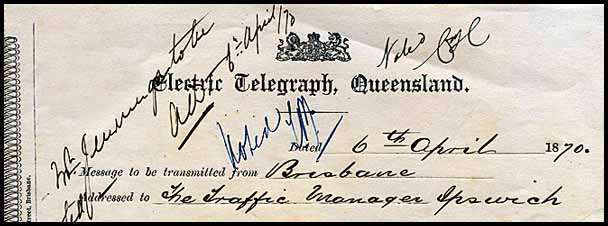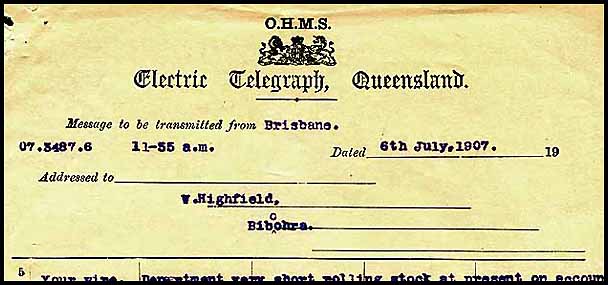Electric Telegraph ordinary rate transmission forms.
- Australia 1901-1988
- New South Wales
- Overview of NSW
- Telegraph lines
- Telegraph Offices
- Date stamps
- Forms
- Envelopes
- Instructional annotation
- Collect
- Delayed
- Free
- Immediate Urgent
- Reply paid
- Rates
- Stamps
- 1871 Telegraph stamps
- 1885 proposal
- 1893 proposal
- Queensland
- South Australia
- Tasmania
- Victoria
- Western Australia
- International
- Special aspects
The menus below link to:
- Ordinary rate transmission forms;
- OHMS ordinary rate transmission forms.
Rates for sending telegrams in Queensland up to 1901 are summarised elsewhere.
A note on URGENT telegrams has been added below. No URGENT rate transmission forms have been recorded.
1. Ordinary rate transmission forms.
| QC-TO-1.
Has a Crest at the top above the standard heading. Has serrated edge on the left and design showing these forms had been bound into a book. |
 |
| QC-TO-3.
Has 10 rows of 5 boxes for the message numbered at the left. Has one line above the message area for the address. |
 |
| QC-TO-4.
Printed image of Queen's head in green to pre-pay the cost of an inland telegram. Postal Note details on front with three lines for a message on reverse. |
 |
| QC-TO-5.
Printed image of Queen's head in brown to pre-pay the cost of an inland telegram. Two lines of five boxes below for message. |
 |
| QC-TO-6.
ELECTRIC TELEGRAPH beneath crest. Message to be transmitted from BRISBANE. |
 |
2. OHMS ordinary rate transmission forms.
| QC-TO-OHMS-1.
OHMS above Crest. Stub from a bound book of transmission forms used for transmission under official O.H.M.S regulations. It is assumed that the torn off form would look identical. |
 |
|
OHMS above Crest. The Lion and the Unicorn are both facing away from the Shield. Heading in large Gothic letters.
|
 |
|
OHMS above Crest. The Lion and the Unicorn are both facing towards the Shield. Heading in smaller Gothic letters. Has a decorative dot in the centre of the line under TELEGRAPH. |
 |
Introduction of an URGENT rate.
In the late 1870s, Queensland introduced an "URGENT" code for sending telegrams.
In his 1876 Annual Report, Mr. W. J. Cracknell made the following comment:
"I would further suggest that similar provision be made to that contained in clause 1 of Regulation 44 adopted by the International Telegraph Convention, held at St. Petersburg, last year, viz: 'That the sender of a private telegram may obtain priority of transmission by writing the word URGENT before the address and paying three times the ordinary rate of charge'. To ensure greater accuracy, telegrams so transmitted might be registered and repeated back in sections".
Details of the use of an URGENT rate in Queensland and its implications cannot yet be fully determined. In his 1880 Report (tabled in June 1881), Mr. McDonnell noted that "the code is steadily increasing in public favour. The adoption of such a code causes no appreciable delay to ordinary business and the advantages to those using it cannot be over-estimated. For the 12 months ended December 1880, 10,025 messages were transmitted, value £1,598 18s 4d. During the first four months of this year (1881) 4,484 messages, value £684 4s 6d as against 2,394 messages, value £408 8s 6d during the first four months of 1880, have passed over the Queensland lines. When it is considered that"urgent" telegrams are only received for stations within the Colony, this increase of nearly 50% in the number of messages may be looked upon as very satisfactory ... I believe New Zealand (where such a code was introduced in 1877) and Queensland are the only Australian Colonies where the "Urgent" system has been adopted".
There are no known Queensland transmission forms for sending Urgent messages and no reference to any such forms. Tasmania appears to he however introduced such forms during the 1880s. There are Queensland Urgent rate delivery forms dating from the 1880s and these can be referenced elsewhere.